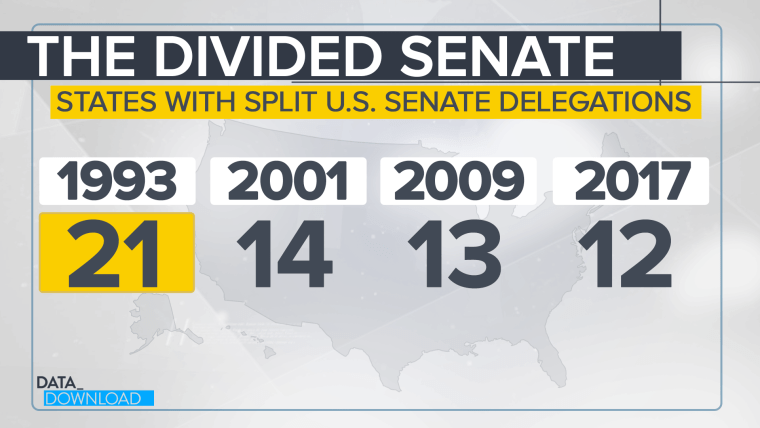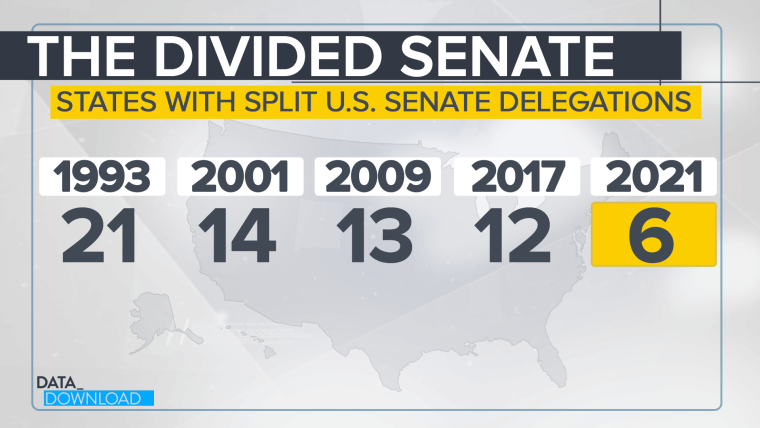WASHINGTON — Donald Trump's second impeachment trial followed a very predictable partisan path in the Senate last week, with Democrats voting to convict and most Republicans voting to acquit. There's a long list of reasons, but one of them is the increasingly tidy alignment between the Senate and the presidential partisan maps.
It used to be that many states had divided Senate delegations and that presidents won the vote in states represented by the opposite party in the Senate. But the pattern has been in decline for decades, and it has advanced to the point where today, the presidential election and the Senate maps look remarkably similar.
You can get a sense of the change by going back to 1993, when President Bill Clinton came to Washington after 12 years of Republicans in the White House. Clinton won 32 states in 1992, and those states held a lot of partisan diversity in the Senate.

Just under half of the states he won, 15, were represented by two Democrats. Three of the states he won were represented by two Republicans. And close to half, 14, were represented by split delegations: one Democrat and one Republican.
In the Republican and split states, the senators from the opposing party were answering to voters who had just elected a Democrat to the White House. There was some impetus to reach out to work together — or, at least, to feign working together.
In addition, three states with two Democratic senators didn't vote for Clinton. The point is that the partisan line was blurrier back then, but it has become much clearer since then.
Barack Obama carried 28 states in 2008, when was a noticeable increase in the partisanship of the coalition of states in the Senate.
Two-thirds of the states Obama won, 19, were represented by two Democrats. One state that voted for Obama, Maine, was represented by two Republicans. And eight of the states that voted for him were represented by split delegations.
In addition, four states with two Democratic Senators didn't vote for Obama: Arkansas, West Virginia, Montana and North Dakota, which were on their way to taking on a more Republican cast. Six of those states' eight Senate seats are now held by Republicans.
The net impact was that Obama had to lean more heavily on a purely Democratic group of senators. He held less electoral sway over Republican and split delegations.
But the numbers still look relatively bipartisan compared to where we are today. The 2020 presidential results line up almost perfectly with the partisanship of the Senate delegations.
President Joe Biden won 25 states on his way to the White House, 22 of them with two Democratic senators. The three others were states with split delegations. None were states with two Republicans.
That probably limits the power of Biden's presidential bully pulpit to sway the other side in the Senate. It also suggests something of why we saw such loyalty to former President Donald Trump in last week's impeachment trial. The overwhelmingly majority of Senate Republicans — all but three — come from states that voted for Trump.
Download the NBC News app for breaking news and politics
The Democratic wins in Republican states have shrunk considerably and consistently since Clinton was elected. Some of that has to do with shifts in the politics of those states. It seems remarkable, for example, that Oregon had two Republican senators in 1993 (or that Alabama had two Democrats).
But the other sharp decline in these data comes among presidents who won states with split delegations. And that has less to do with their being able to appeal to "split states" than it does with the fact that there just aren't many states with split delegations anymore. Split Senate delegations have become an endangered species.

In 1993, during Clinton's first term, close to half the states had split delegations. By George W. Bush's first term, which began in 2001, the number was 14. It was 13 states for Obama's first term and 12 for Trump's term. Now only a half-dozen states have split Senate delegations.
That means that when a new president arrives in town and hopes to craft an agenda, he is immediately dealing with a Senate in which the partisan divisions are stark and there is likely to be little motivation for compromise. It also means you're more likely to get the very partisan story of the impeachment trial last week.
None of this means that the behavior that defines the Senate is "wise" or "good for politics," but it isn't irrational, either, considering the divisions running through the country. Over the last 30 years the voters have spoken, and they have created a deeply partisan body on Capitol Hill.